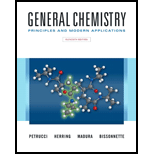
(a)
Interpretation:
The dependence of E in some half-cell reactions on pH should be explained.
Concept introduction:
In an
If oxidation takes place on an electrode, that electrode is called anode. The removal of electrons takes place from the species present in anode.
If reduction takes place on an electrode, that electrode is called cathode. The addition of electrons takes place to the species present in cathode. The electrode potential of cell is calculated from reduction electrode potential of cathode and anode as follows:
Nernst equation;
Z = number of moles of electrons transferred in the cell.
(b)
Interpretation:
Whenever H+ appears in a half-cell equation the reason for it to be on the left side should be explained.
Concept introduction:
In an electrochemical cell there are two electrodes that can be observed. Electrodes are named according to their tendency of oxidation or reduction.
If oxidation takes place on an electrode, that electrode is called anode. The removal of electrons takes place from the species present in anode.
If reduction takes place on an electrode, that electrode is called cathode. The addition of electrons takes place to the species present in cathode.
(c)
Interpretation:
Whenever OH- appears in a half-cell equation the reason for it to be on the right side should be explained.
Concept introduction:
In an electrochemical cell there are two electrodes that can be observed. Electrodes are named according to their tendency of oxidation or reduction.
If oxidation takes place on an electrode, that electrode is called anode. The removal of electrons takes place from the species present in anode.
If reduction takes place on an electrode, that electrode is called cathode. The addition of electrons takes place to the species present in cathode.
Want to see the full answer?
Check out a sample textbook solution
Chapter 19 Solutions
GENERAL CHEMISTRY-MOD.MASTERINGCHEM.
- Consider a voltaic cell in which the following reaction takes place in basic medium at 25°C. 2NO3-(aq)+3S2(aq)+4H2O3S(s)+2NO(g)+8OH(aq) (a) Calculate E°. (b) Write the Nernst equation for the cell E. (c) Calculate E under the following conditions: PNO=0.994atm,ph=13.7,[S2]=0.154M,[NO3-]=0.472M, .arrow_forwardTwo Ag+(aq) | Ag(s) half-cells are constructed. The first has [Ag+] = 1.0 M, the second has [Ag+] = 1.0 105 M. When linked together with a salt bridge and external circuit, a cell potential is observed. (This kind of voltaic cell is referred to as a concentration cell.) (a) Draw a picture of this cell, labeling all components. Indicate the cathode and the anode, and indicate in which direction electrons flow in the external circuit. (b) Calculate the cell potential at 298 K.arrow_forwardConsider the galvanic cell based on the following half-reactions: a. Determine the overall cell reaction and calculate b. Calculate G and K for the cell reaction at 25C. c. Calculate at 25C when [Au3+] = 1.0 102 M and [Tl+] = 1.0 104 M.arrow_forward
- Consider a battery made from one half-cell that consists of a capper electrode in 1 M CuSO4 solution and another half—cell that consists of a lead electrode in 1 M Pb(NO3)2 solution. (a) What are the reactions at the anode, cathode, and the overall reaction? (b) What is the standard cell potential for the battery? (c) Most devices designed to use dry-cell batteries can operate between 1.0 and 1.5 V. Could this tell he used to make a battery that could replace a dry-cell battery? Why or why not. (d) Suppose sulfuric acid is added to the half—cell with the lead electrode and some PbSO4(s) forms. Would the cell potential increase, decrease, or remain the same?arrow_forwardA galvanic cell is based on the following half-reactions: In this cell, the copper compartment contains a copper electrode and [Cu2+] = 1.00 M, and the vanadium compartment contains a vanadium electrode and V2+ at an unknown concentration. The compartment containing the vanadium (1.00 L of solution) was titrated with 0.0800 M H2EDTA2, resulting in the reaction H2EDTA2(aq)+V2+(aq)VEDTA2(aq)+2H+(aq)K=? The potential of the cell was monitored to determine the stoichiometric point for the process, which occurred at a volume of 500.0 mL H2EDTA2 solution added. At the stoichiometric point, was observed to be 1 .98 V. The solution was buffered at a pH of 10.00. a. Calculate before the titration was carried out. b. Calculate the value of the equilibrium constant, K, for the titration reaction. c. Calculate at the halfway point in the titration.arrow_forwardConsider the voltaic cell 2 Ag+(aq) + Cd(s) 2 Ag(s) + Cd2+(aq) operating at 298 K. (a) Calculate the Ecell for this cell. (b) If (cone. Cd2+) = 2.0 M and (cone. Ag+) = 0.25 M, calculate Ecell. (c) If Ecell = 1.25 V and (cone. Cd2+) = 0.100 M, calculate(cone. Ag+).arrow_forward
 ChemistryChemistryISBN:9781305957404Author:Steven S. Zumdahl, Susan A. Zumdahl, Donald J. DeCostePublisher:Cengage Learning
ChemistryChemistryISBN:9781305957404Author:Steven S. Zumdahl, Susan A. Zumdahl, Donald J. DeCostePublisher:Cengage Learning
 Chemistry: An Atoms First ApproachChemistryISBN:9781305079243Author:Steven S. Zumdahl, Susan A. ZumdahlPublisher:Cengage Learning
Chemistry: An Atoms First ApproachChemistryISBN:9781305079243Author:Steven S. Zumdahl, Susan A. ZumdahlPublisher:Cengage Learning Chemistry: Principles and ReactionsChemistryISBN:9781305079373Author:William L. Masterton, Cecile N. HurleyPublisher:Cengage Learning
Chemistry: Principles and ReactionsChemistryISBN:9781305079373Author:William L. Masterton, Cecile N. HurleyPublisher:Cengage Learning Chemistry by OpenStax (2015-05-04)ChemistryISBN:9781938168390Author:Klaus Theopold, Richard H Langley, Paul Flowers, William R. Robinson, Mark BlaserPublisher:OpenStax
Chemistry by OpenStax (2015-05-04)ChemistryISBN:9781938168390Author:Klaus Theopold, Richard H Langley, Paul Flowers, William R. Robinson, Mark BlaserPublisher:OpenStax Chemistry: The Molecular ScienceChemistryISBN:9781285199047Author:John W. Moore, Conrad L. StanitskiPublisher:Cengage Learning
Chemistry: The Molecular ScienceChemistryISBN:9781285199047Author:John W. Moore, Conrad L. StanitskiPublisher:Cengage Learning





